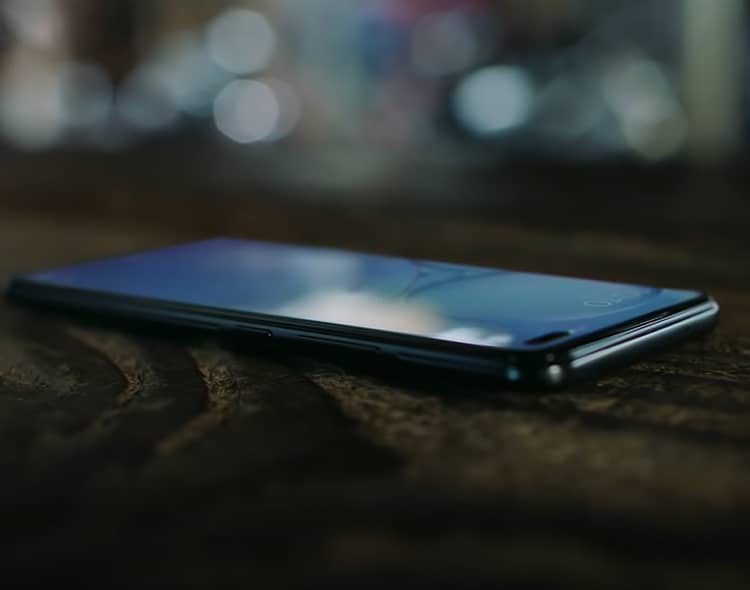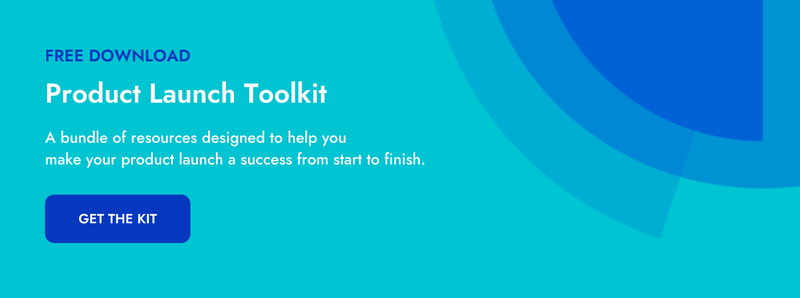For your company’s new product to succeed, a lot of dominoes need to fall.
It needs to relieve the right pain points. It needs to be priced appropriately. It needs to stand out—functionally or otherwise—from alternatives in the market.
And, crucially, it needs to be properly introduced to prospective customers—introduced in a manner that generates awareness, demand, and, ultimately, adoption.
Today’s blog post is all about five brands that have successfully launched new products. Once we’ve explored their stories and campaigns, we’ll wrap up with three additional tips for product launch success.
READY TO NAIL YOUR NEXT LAUNCH? DOWNLOAD OUR PRODUCT LAUNCH TOOLKIT ↓
5 product launch examples that we can all learn from
Of course, this is a non-exhaustive list. If we’ve overlooked any of your favorite examples of successful product launches, let us know in the comments section below!
1. Cox Communications
The education technology (EdTech) industry is a massive one—and not one that’s particularly easy to break into. It’s valued at more than $100 billion, and it’s constituted by firms like Chegg, Blackboard, and Google.
So, as Cox Communications—the third-largest cable television provider in the U.S.—was preparing to launch a children’s educational app called FastTrack, it was obvious that they had their work cut out for them.
The strategy, though multi-pronged, was simple: Build an email list.
With their no-B.S. landing page ready to go, they bought ads on Facebook and targeted moms. From there, they were able to accumulate followers, generate awareness, and capture contact information.
All the while, the Cox team was also working hard to identify influential bloggers and industry thought leaders. The subsequent outreach campaign was designed to forge strategic relationships and secure opportunities for guest blogging—and it was a huge success. Each guest blog (obviously) drove traffic to the landing page, and one of them even went viral.
In the end, 6% of the overall target audience converted to FastTrack—proof that, despite the major players already in the market, there was still an appetite for cutting-edge digital programs.
What this means for you
Whether your company is B2C or B2B, thought leaders matter. Ipsos finds that 87% of buyers take into account the reputation of the company when purchasing a solution. When you secure the endorsement of a thought leader—or, at least, get in front of their audience—you substantially improve your brand’s reputation in the eyes of your prospects. Earning trust in advance of a product launch is a tremendous way to drive adoption out of the gate.
2. Vivo
For all the convenience of ecommerce, certain shopping experiences are more enjoyable when conducted offline. Take smartphone shopping, for example: Who doesn’t love getting a feel for a new phone, playing around with different features and testing out the camera?

Via Facebook.
The marketing team at Vivo—a Chinese technology company with a presence in more than 100 countries—is aware of this preference, and they were put to the test in the midst of the Covid-19 pandemic. As they prepared to launch their V19 smartphone, they faced a tough question: With in-person gatherings out of the question, how can we use digital channels to replicate the traditional shopping experience and generate excitement around our new product?
The answer: Augmented reality. Often shortened to AR, augmented reality is “an enhanced version of the real physical world that is achieved through the use of … sensory stimuli delivered via technology.”
More specifically, Vivo launched their V19 smartphone with an AR ad campaign across Facebook and Instagram Stories. Targeting Indian consumers between the ages of 18 and 35, the company invited prospects to experience a “virtual unboxing” of the phone, and they even ran a contest based around the hashtag #vivo19outofthebox.
Ultimately, the tech brand observed a 9.5-point increase in ad recall—which refers to the estimated number of consumers who would remember an ad if they were asked about it two days later—and a tripling of click-through rate compared to previous campaigns.
What this means for you
Always stay on your toes. Although pandemics are pretty rare, it’s not uncommon to hit bumps in the road as your company gears up to launch a new product. QA uncovers more defects than expected. Focus groups respond poorly to messaging. Market shifts reveal previously unseen pain points. Specifics aside, what’s important is that you maintain clear and candid communication with your stakeholders and that everyone remains on the same page.
3. Noluma
Did you know that milk begins to lose Vitamin A after just two hours of exposure to light?
This is just one of the revelations from “Packaged Foods Should Be Kept In the Dark: Consumers Shouldn’t Be,” a report published by U.K. light protection services and certification company Noluma.
Their findings made clear that there’s a need for light-protected milk packaging. But when they spoke with prospective clients—i.e., companies that process, package, and sell milk—they learned that, before they could launch, they needed to prove that consumers actually care about the problems their report revealed.
So, after conducting more than a dozen focus groups and surveying consumers on their nutritional outlooks and shopping habits, Noluma ran an influencer-supported B2C marketing campaign called “Light Damage Is Real.” Supplemented by a website and a “Dairy In the Dark” pop-up tasting experience, the campaign succeeded in its mission to generate awareness of dairy nutrient loss—and to generate demand for Noluma’s innovative packaging product.
With the consumer side of the equation taken care of, the company was able to run a LinkedIn lead generation campaign targeted at B2B prospects. All in all, they captured information from thousands of decision-makers, closed several major deals, and secured commitments to millions of light-protected milk packages.
Plus, months after the conclusion of their campaigns, Noluma found that the majority of survey respondents had heard of them—and one-third knew that the brand does work related to light protection.
What this means for you
Nothing moves the needle quite like proprietary data. In the case of Noluma, they leveraged data on two fronts: lab data that won over consumers and consumer data that won over B2B buyers. Although your company may not need to go as far as publishing a report in scientific publications, it’s worth considering how you might use data to validate your value proposition and drive adoption. Again, this ties back to our earlier discussion regarding reputation and trust.
4. KFC
If you asked a random sample of people what they eat during the holiday season, many would say turkey and/or ham—and considerably fewer would say chicken.
This is less than ideal for the iconic fast food chain known as Kentucky Fried Chicken, which specializes in … well, fried chicken. The final six weeks of the calendar year are defined, in part, by a massive spike in consumer spending, and yet the Colonel & co. are left out in the cold.
So, the folks at KFC asked themselves a question: Can we launch a new product that will generate awareness of and demand for our beloved fried chicken during the holidays?
Behold—the KFC 11 Herbs and Spices Firelog:

Via Edelman.
Yup. As some of you may remember, the Yum! Brands subsidiary sold a firelog that, when ignited, made consumers’ homes smell like fried chicken. The idea was that:
- The fireplace plays an essential role in the holiday season, and
- The smell of fried chicken makes people want to eat fried chicken.
The results of this product launch speak for themselves. Discussion on TV shows like Jimmy Kimmel, The Jam, and ESPN’s Jalen & Jacoby. Coverage in publications like BuzzFeed, Cosmopolitan, and The New York Times. Nearly 5,000 user-generated social posts.
Oh, and the logs sold out in three hours—only for some of them to be resold on eBay for as much as $250.
What this means for you
Be bold. Do you think each and every person at KFC was 100% certain this idea would work out? Absolutely not. And yet, despite the not-small chance that the 11 Herbs and Spices Firelog would be a laughable failure, they went for it anyway. And to be clear, boldness is not reserved exclusively for B2C brands. Stock footage company Dissolve once went viral—in a good way—when they published This Is a Generic Brand Video on YouTube. Sometimes, your company needs to take a risk in the marketing department.
5. Lifesize
A popular brand like KFC launching a fun, seasonal product is one thing. A startup like Noluma launching an innovative solution to a virtually unknown problem is another thing.
And then there’s Lifesize—a now-established firm that, as a startup in 2005, dared to enter an industry that (believe it or not) had been around for quite some time: video-conferencing.
Their differentiator? High-definition video-conferencing. The team at Lifesize knew it was a cutting-edge idea, and they needed to launch their company in a manner that generated both excitement and leads.
They settled on the Interop trade show, an event that brings together thousands of IT professionals from around the world. It was the perfect opportunity to get in front of their target audience, demonstrate the unique benefits of their solution, and position themselves as the emerging market leader.
Months before the event, the Lifesize team encouraged prospects to visit their booth—while maintaining a degree of secrecy—through a campaign that combined email, direct mail, and online advertising. Crucially, they also invested in pre-launch staff training to make sure everyone was on the same page from a messaging and product demonstration perspective.
Both investments paid off in a big way, as their marketing campaign captured 750 leads (400% of goal) and their staff conducted 20 sales meetings throughout the event (300% of goal). Within only weeks of Interop wrapping up, Lifesize was fulfilling more orders and running more meetings than they’d initially anticipated.
What this means for you
Consistency is critical—and that’s never more true than when you’re bringing a new product (or company) to market. Had Lifesize sent their staff to Interop without any pre-launch training, their messaging would’ve been all over the place, resulting in a confusing and unimpressive experience for prospective customers. Whether your company is launching a new product via an industry event, a Facebook advertising campaign, a guest posting initiative, or something in between, make sure everyone understands your position in the market and knows how to elucidate the unique benefits of your solution.
3 extra tips for product launch success
Whew! We just covered a lot of ground. We hope you find those examples helpful, but in case you’re looking for a bit more guidance, here are three extra tips for product launch success.
1. Segment your launch plan
As you’re sketching out your product launch plan, it can be helpful to segment that plan into distinct phases or sections. Examples include …
- Researching the market and competition
- Developing the buyer persona(s)
- Building the internal positioning framework
… and so on. Without any kind of segmentation, there’s a greater risk of falling behind and/or failing to dedicate sufficient time to certain phases.
2. Stay focused on your ideal buyer
We’ve explored quite a few tactics throughout this post—teaming up with thought leaders, leveraging AR, earning media coverage, etc. Although these tactics work extraordinarily well with some audiences, they’d be utterly ineffective with others. To ensure that you’re generating adequate awareness and demand—and doing so amongst the right people—keep your ideal buyer in mind at all times. Your approach should be bold, but it should be targeted, too.
3. Measure success & learn for next time
Each and every product launch is a learning opportunity. No matter what, you should walk away with a better understanding of your target market and the people who comprise it. Questions for you and your team to consider include …
- Which marketing channels and tactics were most effective? Which were least effective?
- How strong (or weak) is adoption thus far?
- What feedback, if any, have we gotten from prospects and customers?
… and so on. The more thorough you are in the examination of your product launch, the greater your chances of delivering better results next time.
Don’t forget your product launch toolkit
Examples and best practices are all well and good, but in order to consistently knock your product launches out of the park, you’ll need some additional collateral.
With Crayon’s free Product Launch Toolkit, you’ll get everything you need to prepare, execute, and evaluate your company’s next product launch. While our playbook will help your team ensure that every box is checked, our retrospective will help your team ensure that the next initiative is the most successful one yet. Plus, our on-demand webinar will provide a fresh perspective on the use of competitive intelligence in the product launch process.
Download your toolkit today!




